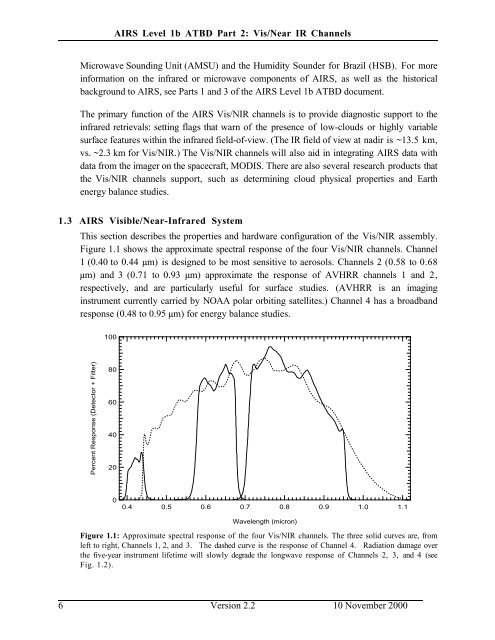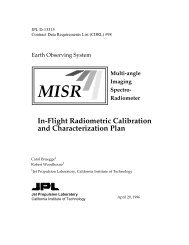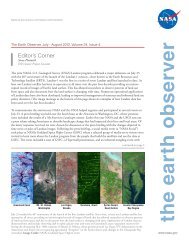AIRS Level 1B Visible/Near-Infrared Channels ATBD - NASA's Earth ...
AIRS Level 1B Visible/Near-Infrared Channels ATBD - NASA's Earth ...
AIRS Level 1B Visible/Near-Infrared Channels ATBD - NASA's Earth ...
You also want an ePaper? Increase the reach of your titles
YUMPU automatically turns print PDFs into web optimized ePapers that Google loves.
<strong>AIRS</strong> <strong>Level</strong> 1b <strong>ATBD</strong> Part 2: Vis/<strong>Near</strong> IR <strong>Channels</strong><br />
Microwave Sounding Unit (AMSU) and the Humidity Sounder for Brazil (HSB). For more<br />
information on the infrared or microwave components of <strong>AIRS</strong>, as well as the historical<br />
background to <strong>AIRS</strong>, see Parts 1 and 3 of the <strong>AIRS</strong> <strong>Level</strong> 1b <strong>ATBD</strong> document.<br />
The primary function of the <strong>AIRS</strong> Vis/NIR channels is to provide diagnostic support to the<br />
infrared retrievals: setting flags that warn of the presence of low-clouds or highly variable<br />
surface features within the infrared field-of-view. (The IR field of view at nadir is ~13.5 km,<br />
vs. ~2.3 km for Vis/NIR.) The Vis/NIR channels will also aid in integrating <strong>AIRS</strong> data with<br />
data from the imager on the spacecraft, MODIS. There are also several research products that<br />
the Vis/NIR channels support, such as determining cloud physical properties and <strong>Earth</strong><br />
energy balance studies.<br />
1.3 <strong>AIRS</strong> <strong>Visible</strong>/<strong>Near</strong>-<strong>Infrared</strong> System<br />
This section describes the properties and hardware configuration of the Vis/NIR assembly.<br />
Figure 1.1 shows the approximate spectral response of the four Vis/NIR channels. Channel<br />
1 (0.40 to 0.44 µm) is designed to be most sensitive to aerosols. <strong>Channels</strong> 2 (0.58 to 0.68<br />
µm) and 3 (0.71 to 0.93 µm) approximate the response of AVHRR channels 1 and 2,<br />
respectively, and are particularly useful for surface studies. (AVHRR is an imaging<br />
instrument currently carried by NOAA polar orbiting satellites.) Channel 4 has a broadband<br />
response (0.48 to 0.95 µm) for energy balance studies.<br />
100<br />
Percent Response (Detector + Filter)<br />
80<br />
60<br />
40<br />
20<br />
0<br />
0.4<br />
0.5<br />
0.6<br />
0.7<br />
0.8<br />
0.9<br />
1.0<br />
1.1<br />
Wavelength (micron)<br />
Figure 1.1: Approximate spectral response of the four Vis/NIR channels. The three solid curves are, from<br />
left to right, <strong>Channels</strong> 1, 2, and 3. The dashed curve is the response of Channel 4. Radiation damage over<br />
the five-year instrument lifetime will slowly degrade the longwave response of <strong>Channels</strong> 2, 3, and 4 (see<br />
Fig. 1.2).<br />
6 Version 2.2 10 November 2000







